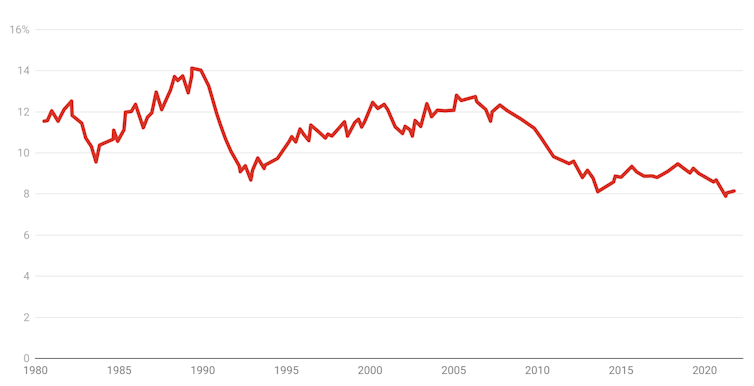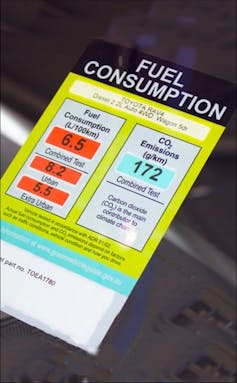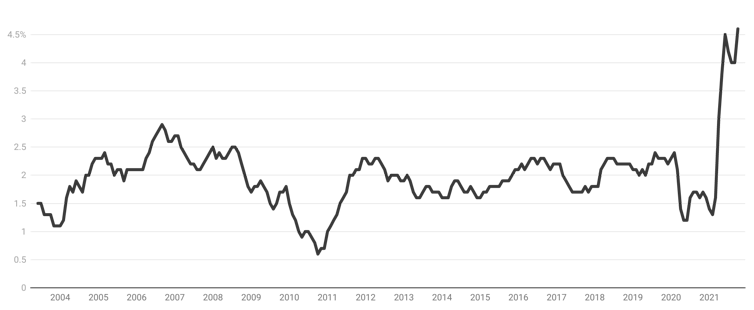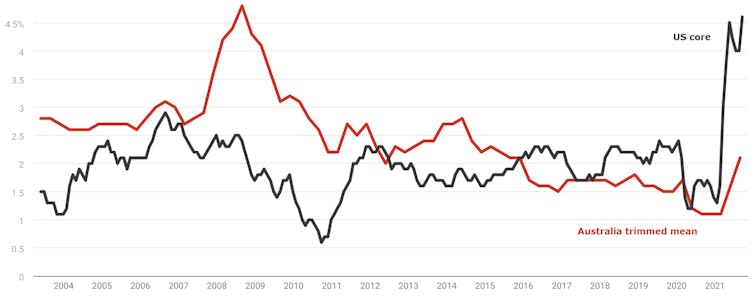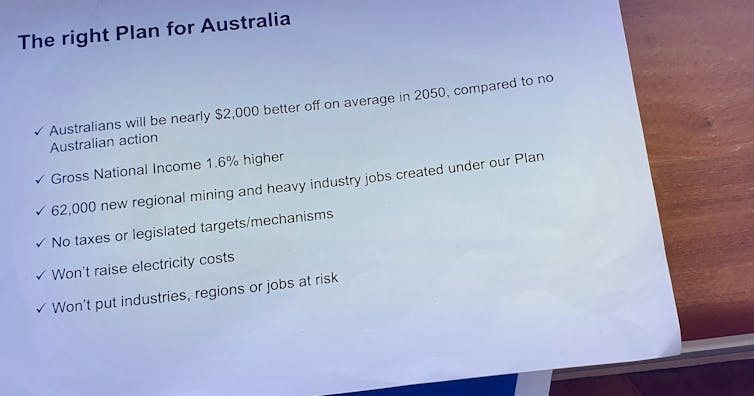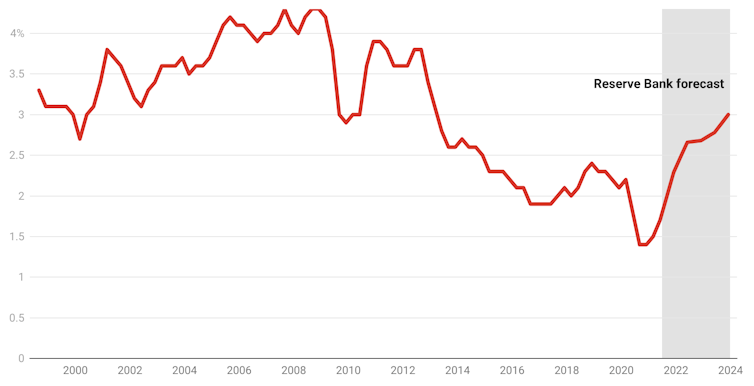Like many journalists who’ve honed their careers at the ABC, economics writer Peter Martin began in a small local newsroom and moved through the ranks to become a specialist reporter and a foreign correspondent. Having subsequently worked in commercial media, he has a renewed appreciation of the ABC, both professionally and personally. Here he reflects on his strong lifetime attachment to the ABC, and the lessons he’s learnt about both the skills of the profession and the responsibilities of being a public broadcaster.
By Peter Martin November 25, 2021
I was recently asked to talk to ABC Friends at Armidale, in the Northern Tablelands of NSW, about my two decades at the ABC.
It reminded me of my first ABC job interview… well it wasn’t an interview at first, it was a phone call. An ABC news executive named Ian Wolfe had phoned me at work in the Commonwealth Treasury after I had submitted an application aged 25 and said — “we’ve got to talk”.
We arranged a time, not at my work, and I started spouting all sorts of pent-up thoughts about the ABC local Canberra news and how we could make it better.
I should point out that the ABC local Canberra news is not to be confused with the ABC’s parliament house newsroom which deals with national issues.
It’s analogous to the ABC New England North West news – it covers what’s happening where listeners live, for what was then the 250,000 or so listeners who lived in and around Canberra.
There are more than 50 such newsrooms across the country from Esperance to the Eyre Peninsula, from Ballarat to Broken Hill, and in busy rural centres like Tamworth, Port Macquarie and Muswellbrook.
I mention Muswellbrook because my wife Toni Hassan was ‘the newsroom’ there. When I say she ‘was the newsroom’, it was (and is) a one-person newsroom. She would get in early to update and present the radio news, then spend the rest of the day out and about meeting people and writing about it for the next bulletin.She was embraced by the community and became important to it.
Later she went on to win a Walkley award and a Human Rights award for her reporting on the health of asylum seekers in detention, but she began her ABC career in Muswellbrook.
Sally Sara began her ABC career in Renmark in South Australia’s Riverland. Later she reported from Africa for the ABC (twice) and from Jakarta, India and Afghanistan, presented Landline and now presents The World Today.
But she started in Renmark, being embraced by and reporting to her local community.
No other organisation has anything like the presence of the ABC throughout Australia. Fairfax Media, now part of Nine Entertainment, the organisation I worked for until recently, has hardly any reporters away from Sydney, Melbourne, Canberra, Perth and Brisbane. It has no reporter in Adelaide, none in Darwin and none in inland Australia. It relies on phone calls.
The ABC doesn’t have to. It is in all of those places and in many, many more domestically and internationally. It attends the press conferences, meets the people who are planning and doing things.
Sometimes being on the spot had unexpected consequences.
When I was in Japan as the ABC’s Tokyo correspondent, I got into a fight of sorts with the Adelaide Advertiser. Feeling the need to support South Australian industry in the form of Adelaide’s Mitsubishi car plant, it insisted that my reporting from Tokyo about Mitsubishi’s plans to shut down the Adelaide plant was wrong.
But it wasn’t wrong. I was there talking to the Tokyo executives, attending the Tokyo press conferences with a translator, a camera and a microphone. The Advertiser wasn’t.
Like most of the Australian media apart from the ABC, the Advertiser didn’t know what was happening on the ground.
The ABC has staff in Port Moresby, Jakarta, Tokyo, Bangkok, New Delhi, Nairobi, Beirut and Jerusalem, as well as Washington and London, and when possible in Beijing. This is expensive, but it lets the ABC do what no other Australian organisation can do: report from the ground, where things are happening.
Commercial TV networks typically have two overseas bureaus; in London and Los Angeles. A lot of the work they do there is watching TV and adding value where they can. There are exceptions of course, such as Amelia Adams’ coverage of the January 6 storming of the Capitol building in Washington for the Nine Network. But nonetheless the commercials choose Los Angeles rather than New York or Washington for their US bases not because more happens there but because the time zone makes it easier to co-ordinate TV feeds with Sydney.
But I’m getting ahead of myself.
I was on my lunch break from the Treasury, talking to ABC news executive Ian Wolfe at a million miles an hour.
He stopped me, slowed me down, and said — tell me about yourself.
His key question to me in that cramped room I’d found in an office away from the Treasury was… why? You’re an economics graduate, you’re handling briefs that go to the Treasurer… why would you want to leave that to report on local news, he asked me.
I told him it was because it was the most fun you could have (I’d worked in community radio) and the work that mattered the most.
Later, at another time, I told him about the ABC and me… about how as a child in Adelaide I would wake up at 5.50 am so I could go to the kitchen to hear the ABC radio test tone, then the sound of a kookaburra and the national anthem at 6 am, followed by the day’s first programs: “Readings from the Bible” and “English for new Australians”.
And I told him about how later, when I got my own radio, which glowed at night (it had valves) I would leave it on throughout the night, the volume turned down, because it was my friend; about how when I went through the list of the things I would rescue from the house should it burn down, the only one on my list was my Bakelite Stromberg-Carlson radio.
… About how later on at night my mind was expanded by the voices of experts from around the world on Radio 2’s LateLine, whose closest equivalent these days is Late Night Live.
… About the radio plays that took me to another world in the way TV could not have done, about how they made me read the books.
… About how the subjects I’d chosen at university were ones I thought might help me to work at the ABC. I chose drama, the acting course (so I could work on radio plays), politics (so I could be a reporter on radio current affairs programs), and economics because… well, it looked new and exciting, and no-one knew what was going on.
I abandoned drama, concentrated on economics, and in my last year the Treasury asked me to leave Adelaide and come to Canberra.
I did, but let’s put it this way. When I left to go to the ABC a colleague wrote on my card “now you’ll be a round peg in a round hole”.
Learning the ropes
Before going to the ABC I had presented the local Canberra news on the community radio station 2XX, a great training ground because I had to do everything. I collected the news. I phoned people, got to know all the members of the ACT House of Assembly, cycled to Queanbeyan to attend council meetings and lived and breathed the town I was in… because that was my mission… to tell people about it.
I also learnt how to write. There were scarcely any courses for journalists then. Instead, I recorded and typed up ABC and commercial radio news bulletins and looked at the shape of the paragraphs, the length of each sentence, the order of the words, the work each sentence did. Then I replicated it in the pieces I wrote.
To apply for a job advertised at the ABC I typed up a transcript of their local news for that Monday morning, then my version and made the point they were both prepared with the same available information and the same aim of entertaining and informing in the same slot of five minutes.
It was a risk. I didn’t know if it would annoy them or get me the job.
As it turned out, the only hiccup was when Ian Wolfe asked me to send him a tape of my voice. He called me back and it would be fair to say that he wasn’t impressed. But he thought, maybe, after I’d got the job, someone could work on that.
I thought there was no higher calling than telling people what was going on.
Before long I transferred to the ABC in Sydney (a huge and frightening city compared to Canberra or Adelaide), working as a finance reporter, on the news at triple-j and in the ABC Science Unit, in the old William Street premises.
Back in 1984: Peter Martin in the ABC radio news “dog box” at William Street where police, ambulance and fire service radios were monitored.
At times, the jobs overlapped. I remember the glorious balmy evening when I walked to a studio on one side of William Street and presented a science program at 6.30 pm, and then when it finished at 6.55 dodged the traffic to get to the triple-j building on the other side of the street to present the news.
I learned the most about the responsibilities of a public broadcast journalist at ABC radio current affairs, the unit that makes AM, PM, and The World Today.
The executive producer of PM Kerrie Weil was upbraiding us one night for getting something wrong. “You are just caretakers” she told us, adding: “we are all just caretakers”.
What were we taking care of?
A set of traditions that were the ABC’s own. There are no programs quite like AM, PM and The World Today, not on the BBC or anywhere else. They are unopinionated, engaged, fast, and up-to-date, up-to-the-second.
I remember listening to PM one afternoon while sitting on the steps of the National Library in Canberra, reluctant to go in because what I was hearing was so compelling. The presenter Hew Evans was taking Parliament House reporter John Highfield through what had just happened in parliament that afternoon. It was immediate, far more so than would be the newspaper reports the next morning, and unfiltered, yet with context explaining why it mattered, delivered without wasting words.
The style can seem impolite to whoever is being interviewed. That’s because we don’t want to waste the listeners’ time. For AM and PM, the recorded interviews are edited to make them even more concise. We cut out ums and errs.
Questions aren’t merely questions, they are part of a production. We were told to ask a question, get the answer, and then jump in before the interviewee could get to the next point, so that we could ask a question headlining that point. We were creating a piece of theatre, a “to-and-fro”.
And the questions had to be questions. The short ones are the good ones. “Why” is usually the best. Instead of putting to someone allegations that they avoid tax, it is better to ask “do you pay your taxes?”
Some questions are bad ones. “How angry are you?” invites the interviewee to step out of the zone she or he is in and estimate a quantity. A better question is “are you angry?”
If there’s not an answer, you can repeat the question, but (and this is a rule taught to me by former PM presenter Paul Murphy) never more than twice. After hearing the same question three times, the listener will understand that it won’t be answered and you can move on.
For my own interviews I immersed myself in the other person’s head, seeing things from their point of view (something that came easily). It meant I didn’t come across as aggressive or opposed to them in any way.
Each piece had to be short. For AM, typically 2½ minutes, occasionally as many as three.
Radio isn’t like newspapers. Listeners can’t pass over stories that don’t interest them. Unless there’s another story that does interest them coming along very soon, they will turn off. So you don’t waste their time and don’t waste their airwaves.
Also, because it’s not like newspapers, you need to be super clear.
Newspapers are non-linear (to use the jargon). If someone doesn’t understand a sentence in a newspaper they can go back and read it again, or go to the end of a book review and see what the conclusion is, or cast their eye back to when a person or idea was introduced.
Radio is unforgivingly linear. Each step of the argument needs to build on the one before it, it can’t refer back more than a second, and it can’t refer forward. If one step isn’t clear the moment it is outlined the whole thing breaks down.
You should, I was told, imagine you are writing for a grandmother who has the radio on in the kitchen while she is making a cake, preparing for her daughter to visit, and is deaf.
If you can engage her, you’ve done your job.
Oh, and because of developing events, you have to work fast.
Making a difference
Of course, you could learn all the technical skills and still be – in my opinion – an appalling radio current affairs reporter. You could entertain and engage, while only telling people what they already knew, or already believed.
Access to the airwaves is a privilege. Time is the ultimate non-renewable resource. To waste time, to waste the airwaves telling people things they already know or could have guessed, is in my view unforgivable.
We, the people who create content for the airwaves on behalf of the ABC, have the opportunity to give people something extra, to expand their way of thinking about things, just a little bit each time. It’s planting a seed.
It might be that putting more money into superannuation leaves workers with less while they are working; it might be that government debt needn’t ever be paid off; it might be that when investors buy existing homes, owner-occupiers can’t.
I cottoned on to the power and importance of this when I was a child in 1969 watching commercial TV news.
A group of anti-Vietnam War activists had announced plans to publicly burn a pet dog at Flinders University in protest at the use of napalm in Vietnam. They took a photo of the dog and put it in the newspaper.
That night, the TV news reported that they had called it off and included the voices of people in favour of and against, along with vision of the event.
And that’s where it might have stopped.
But the editor or reporter did something else. After the last words, the camera lingered on a flyer, a discarded piece of paper on the ground as someone walked over it.
It read “Napalm burns people”.
The power of that picture and the message it conveyed stayed with me, planted a seed. It didn’t tell me what to think, but it did expand my view of possible views about the world.
Leaving people with something more, enlarging their view of the world just a bit, is to me an honouring of a sacred trust. But it’s hard, mechanically – it takes less time to tell people what they already know.
This is important when you are measuring time on air in seconds, and when you are yourself short of time. Telling people something they don’t know, or suspect, might involve building a new supporting argument which will take up a chunk of the time you are meant to be using for that day’s developments.
So I try to do it a little bit at a time.
These are informal lessons, conveyed by osmosis. Another I learned is that you, the broadcaster, matter. Far more than you will ever fully realise.
I got inklings of this at AM and PM... people would ring in as if I was their friend, as if they knew me, as if I was important to them.
Humbling doesn’t begin to describe the realisation.
Some of these people had few in-person friends. They were stuck at home because they had retired or were infirmed. I was something they had, bouncily sharing my insights and letting them in on what I had heard.
If ‘Comfort’ and ‘Joy’ are two of things that matter most (Comfort and Joy was the title of a 1984 movie about a radio announcer), it’s the privilege of people who are on the radio to provide it.
Many of those who do it best do it innately. But it can be taught.
I was taught it by Arch McKirdy, the legendary presenter of Relax with Me on ABC metropolitan and regional radio in the 1960s and 1970s, one of the best broadcasters there ever was.
When I arrived at ABC Sydney in the mid-1980s he was “Director of Radio Presentation”. And his job was, well, making us human – ideally more human than human, because the airwaves have a flattening effect. You need to be a little bit larger than life to overcome it.
The secret…
He would start by telling us to put the width of a fist between our lips and the microphone, and then to imagine a personal friend on the other side (for me it was my mother Margaret).
Then we had to really value that person, to recognise that they were clever and interested even though they might know nothing about the topic, and then to talk to them, to tell them why it mattered rather than reading words.
I quoted Geraldine Doogue in an obituary I wrote for him Arch in 2013.
“It was about your brain as much as your voice. His contention was that you had to remove every barrier between yourself and your audience, to let people see who you were. And you had to like who you were.”
Perhaps the most important thing I absorbed over two decades at the ABC is that the airwaves belong to the public. Commandeering them to tell people what we think is theft.
Alan Jones, Ray Hadley, perhaps even Phillip Adams are in a different position. But Leigh Sales, Fran Kelly, myself, we’ve no right to tell people what to think. We wouldn’t. It’s an abuse of trust.
So my key lessons boil down to not wasting the airwaves: give people something extra, offer friendship, and don’t steal.
You’ll hear a lot about how the ABC is under threat, and it is, but it has enormous and growing strengths which flow from a long tradition of responsibility and trust.
We would be lost without it. Seriously. Imagine COVID and bushfires without its reliable and comprehensive coverage.
Australians are right to depend on the ABC. And the people who work for our national broadcaster must never forget the obligations that this imposes on them.
Peter Martin AM worked at the ABC for two decades on programs including AM, PM and the World Today, as well as two years as Tokyo correspondent. He is now Business and Economy Editor for The Conversation and a Visiting Fellow at the Crawford School of Public Policy at the Australian National University.


